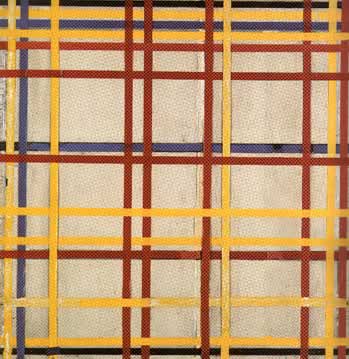As stated previously he used the tape to ‘sketch’ New York City. This painting was made into a proper canvas, while another, New York City II was found purely in its tape form.
He had now come full circle back to the random process of the grid paintings from 1918/19. This may have been what he was aiming for all along. His paintings of 1919 had had a mechanical quality that had been somewhat disturbing in pictures that had been executed by traditional techniques, so in order for his new paintings to achieve a better aesthetic, Mondrian looked for a new pictorial media that was more appropriate to his randomness. On top of this he was in need of a new technique that would be a harmony of the material and design. His New York paintings reflect the ability he had to handle these complex random arrangements of colour and form and to shift and regroup the elements in his pictures.
By this point, Mondrian was far ahead of his European contemporaries and would be the only artist to come close to the works of contemporary American painting. It is thought that he was responsible for the discovery of Jackson Pollock who was one of the most important painters of the fifties. Mondrian had been known to remark that Pollock’s work was some of the most exciting he had seen in years and Pollock produced a style that came to be known in America as an “all-over”. Here Pollock had scattered an impulsive triangle of lines across the surface giving the painting many centres and covering it evenly with forms. This was a form known to Mondrian since 1914!
 New York City II (1944).
New York City II (1944).